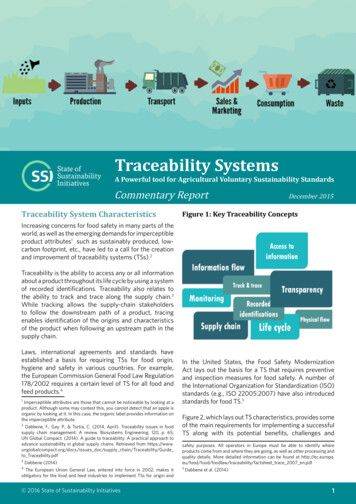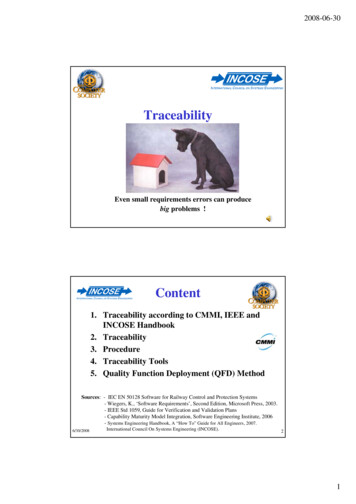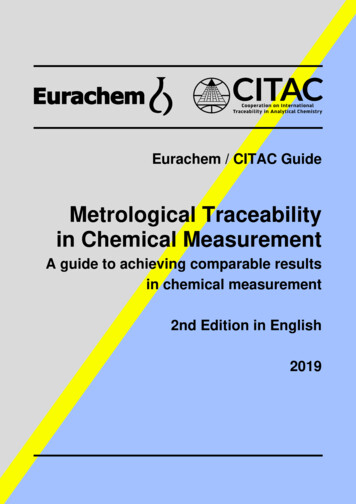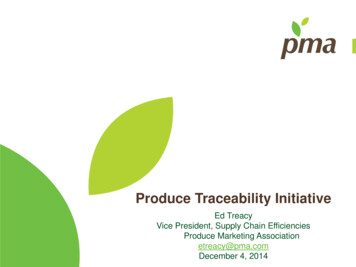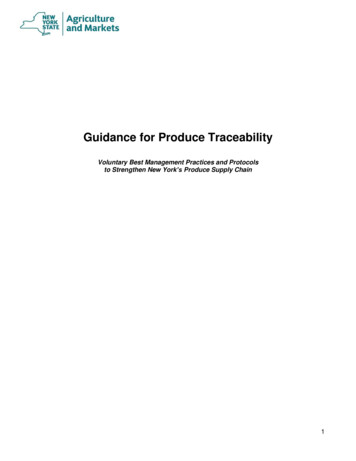
Transcription
Guidance for Produce TraceabilityVoluntary Best Management Practices and Protocolsto Strengthen New York’s Produce Supply Chain1
TABLE OF CONTENTSCONTRIBUTORSFOREWARDOVERVIEWWhat is a Produce Traceability System?Why Create a Traceability System?Who Should Use This Document?Table 1: Typical Roles in the Produce Supply ChainCHALLENGES TO IMPLEMENTING PRODUCE TRACEABILITYESTABLISHING THE COMPONENTS OF A TRACEABILITY SYSTEMStep 1: Creating a Process Flow DiagramFigure 1: Produce Supply Chain Simplified Process Flow DiagramStep 2: Establishing Lot Identifying Units (Lot IDs)Step 3: Product LabelingFigure 2: Examples of Produce Product Labels Identifying a Specific Item From Simple to ComplexFigure 3: Example of Case Label Identifying a Lot IDStep 4: Record KeepingGeneral InformationTraceability Record ContentBasic Record ContentDaily RecordsRecall RecordsPost-Production (Storage Warehouse, Distribution Centers, Shipping) RecordsRecord Retention, Security, and BackupProposed Records of Growing, Receiving, Transforming, Creating, and Shipping Produce onthe FDA’s Food Traceability List (FTL)ADDITIONAL PRODUCE TRACEABILITY RESOURCESAPPENDICESAppendix 1: Glossary of Traceability TermsAppendix 2: A Multi-Point Traceability ChecklistAppendix 3: Example of Completed Process Flow Diagram for Ready-to-eat Fresh Cut VegetablesAppendix 4: Traceability LogAppendix 5: Lot ID/Case/Product Label SamplesAppendix 6: Key Data Elements (KDEs) and Critical Tracking Events (CTEs)Appendix 7: Types of Software to Support TraceabilityAppendix 8: How Traceability Aids in Recall: A Training AideAppendix 9: Buyer Questionnaire TemplateAppendix 10: Simplified Process Flow Template for Small-Medium Growers/Plain Grower CommunitiesAppendix 11: Produce Record Keeping Example for Cash Sales, Small-Medium Businesses, andConvenience Stores, Terminal Markets, and Produce AuctionsAppendix 12: Creating a Communication Plan to Reach CustomersAppendix 13: GS1 TraceabilityAppendix 14: Shopper Cards and TraceabilityAppendix 15: Record RetentionAppendix 16: Examples of Produce Safety Sample Labels/Signs to Educate Consumers2
CONTRIBUTORSThe Department of Agriculture and Markets would like to express its appreciation to the ProduceTraceability Blue Ribbon Task ForceTask Force members for their contributions to the development ofthis Guidance for Produce Traceability document.Membership:Alisha AlbinderHudson River Fruit PackersBethany WallisNOFA – NY, Inc.Elizabeth (Betsy) BihnCornell UniversityBob FerlaFierman Produce ExchangeBob NolanDeer Run FarmsDale Ila RiggsBerry Grower AssociationDarby GrecoNew York State Department of HealthDirk BiemansIntergrowEd HansonHanson FarmsJim BaldwinPrice ChopperJim CalvinNew York Association of Convenience StoresMatt WellsNY Apple SalesMichael KingKrasdaleJim BittnerJim HansBittner Singer OrchardsDriscollJim NortonStewarts ShopsJoel CristCrist Brothers OrchardsJohn Karrat and Sal PalmieriCapitol City ProduceKaari StannardNY Apple SalesLuke GeorgeUpstate Growers & PackersMichael DurantFood Industry AllianceMichael MuzykBaldor Specialty FoodsPaulette SaturSatur FarmsRenee St. JacquesNY Farm BureauRick PedersenPedersen FarmsTim StantonVegetable Growers AssociationSang LeeSang Lee FarmsSteve Ball and Steve StrubWegmans Food Markets, Inc.Steve HoranSpringwater SproutsSteve or Angela KarrPride PakWilliam NiesSpringwater Sprouts3
FOREWORDOn November 12, 2020, New York State Commissioner of Agriculture Richard A. Ball convened aProduce Traceability Blue Ribbon Task Force (Task Force) comprised of growers, processors, packers,distributors, and retailers across multiple produce commodities, to share best practices and bolster thetracing of produce in New York State.The Task Force was established to: gain a better understanding of the variety of approaches being used for traceability throughoutthe produce industry, andprovide best management practices to help all businesses along the produce supply chain refineand improve how they currently trace produce.The Task Force shared information with the Department of Agriculture and Markets (Department)regarding their produce traceability practices and protocols as well challenges they faced withtraceability system development; the costs associated with implementation; variability in buyerrequirements; and interconnectivity, or lack of, with other traceability systems in the produce supplychain. The Department used this information, as well as recommended best practices and publishedmaterial on traceability,1 to create this voluntary best management practices document.This document can be used as a guide for businesses hoping to expand their current traceabilityefforts, those interested in beginning the implementation of an internal traceability system, or those whohandle products that are listed on the proposed Food and Drug Administration’s (FDA) FoodTraceability List. This New York State Guidance for Produce Traceability provides a set of minimumbest practices for traceability and identifies areas that are important to include when developing atraceability system, with each step bolstering the effectiveness of the traceability system. Some of theresources may be more helpful for those looking to enhance current traceability systems, whereasothers may be more applicable for those beginning the implementation process. The goal of thisdocument is to provide useful information for everyone regardless of business size. The Departmentacknowledges that the size of a farm or business may impact its ability to implement some of thepractices outlined due to resource limitations and/or other business priorities, but the implementation ofany of these traceability steps, no matter how minor, will bolster current traceability efforts within theproduce industry in New York State.Improving produce safety depends on all those who support the growth, sale, and distribution of freshproduce. This includes, but is not limited to, farmers, packers, distributors, processors, auctioneers,municipality personnel that sponsor farmers’ markets, not-for-profit personnel that distribute donatedfood, and retailers. All of these individuals should be trained in food safety so they can support theeffective implementation of food safety practices from farm to fork.2It is also important to acknowledge that consumers also have a responsibility to implement food safetypractices during shopping, transporting, storing, and preparing foods in their own homes. As we at theDepartment encourage the fresh produce industry to improve traceability practices, we are alsoencouraging consumers to do their part in keeping the produce they handle and prepare safe forInnovation Center for U.S. Dairy’s “Guidance for Dairy Product Enhanced Traceability”GS1 Traceability for Fresh Fruits and Vegetables Implementation Guide Issue 2, May-2010FAO of the United Nations Food Traceability Guidance Santiago, 20172 gs/food-safety-training-opportunities/14
consumption.While the information outlined in this document, as it relates to the tracing of produce in New YorkState, is intended as guidance, a rise in foodborne outbreaks associated with produce may result in allproduce businesses needing to trace all the produce they grow, process, distribute, and/or sell in thefuture. As such, we encourage all produce businesses in New York to remain leaders in this area andunified in our mission of providing consumers with safe and wholesome fruits and vegetables.We offer our sincere thanks for the effort put forth by all the members of the Task Force and theirwillingness to share their experiences, provide recommendations, and join us in this important effort toimprove the traceability of produce throughout New York.If you have specific questions about this document, please email the Department’s Press Office atpressoffice@agriculture.ny.gov5
OVERVIEWProduce traceability is a process that enables those within the produce supply chain to follow productsforward and backward through the supply chain. Traceability of food products has become the focus ofnational and international legislation; research and technical development initiatives and projects; and manyscientific articles. However, one of the challenges with produce traceability is that there is not consistent,industry accepted terminology to define and differentiate between the components of a traceability system.This can lead to misunderstanding in relation to what a traceability system is, what the components are,and how system functionality can be improved,3 and in the worst case can result in the establishment of anineffective traceability system.This guidance document aims to overcome those challenges by providing terminology definitions and usingconsistent verbiage to describe a voluntary set of systemic best practices, principles, and standards forimplementing an effective traceability system that when used, will enhance how produce is traced from thefarm to the consumer. This guidance document also includes assisting with sales and quality tracking,product recalls, and the tracing of food safety parameters such as customer complaints and foodborneillness outbreaks.Task Force members acknowledged the importance of traceability in being able to quickly respond toissues related to both quality and safety. This is important for consumer confidence in the food supply andin maintaining the reputation of every business. Task Force members also shared that while a level ofautomation improves consistency and proper product identification, hand-writing this information is commonand acceptable. Task Force members relayed that both electronic and handwritten records are pervasive inthe produce supply chain. Additionally, Task Force members with the lowest level of automation describedthat they were able to create good traceability records and track their product through the produce supplychain.What is a Produce Traceability System?In this guidance document, a produce traceability system is used as a generic term encompassing theprinciples, practices, and standards needed to trace produce throughout the supply chain. In practice, mosttraceability systems are computerized and are implemented through the extensive use of informationtechnology, but in principle a traceability system could be manual and paper-based, using the componentsoutlined herein.What are the critical components of a successful produce traceability system? The criticalcomponents of a successful produce traceability system are:1.2.3.A process flow diagram that maps how produce moves through a business.o This diagram should include when and where new produce enters and exits, how lots areestablished, where lots converge, and/or if applicable, where products are transformed (i.e.,carrots and cabbage enter a facility and are transformed into coleslaw).A lot identifying code (Lot ID) that will be used in all the business’ records.Records (manual or electronic) that will assist in expedient and effective recalls.A multi-point checklist is provided at the end of this document as a guide that can be used to identify thecritical steps that are needed to ensure you have a robust, internal and/or external produce traceabilitysystem.3Petter Olsen, Melania Borit, The components of a food traceability system,Trends in Food Science & Technology, Volume 77, 2018, Pages 143-149, ISSN 04. /S0924224417304107)6
What is a lot identifying code (Lot ID)? A Lot ID is a unique number, letter, number-letter combination, orsome other designation that identifies a group or lot of produce.What is an electronic produce traceability system? An electronic produce traceability system maysupport a more complex traceability protocol and result in the more efficient tracing of product. Whileelectronic traceability can be advantageous, no specific platform or operating system is recommended inthis guidance. Many of the Task Force members who already use an electronic traceability system sharedthat they use modules in their electronic platforms for other purposes besides food safety recalls, such asinventory control, invoicing/billing, human resources, payroll, etc. A list of electronic produce traceabilitysystems, and their costs, is provided at the end of this document for informational purposes only (Appendix7). As a business begins to explore the need to implement an electronic traceability system, finding asolution that works well for one’s business, is cost effective, and connects with other suppliers along theproduce supply chain is the key to ensuring that New York has the safest produce supply.Note: This document is intended to be used in tandem with established food safety and quality assurancesystems.Why Create a Traceability System?A traceability system promotes food safety, enhances quality control, and helps a business to meet theexpectations of existing or future buyers, third-party audits, and crop insurance. Traceability data is also anessential element for ensuring the quick and effective management of a product recall. It allows the causeof an issue to be analyzed quickly by tracing the origin of the product and identifying the location ofimplicated product lots in the produce supply chain. For each individual business, a traceability systemusually consists of being able to trace product/lots one step back (i.e., where did it come from) and one stepforward (i.e., where did it go). Ideally, this allows for each product/lot to be traced throughout the producesupply chain, even if the traceability systems used by each individual business are not the same.Traceability systems are incredibly valuable to the produce industry because they can help reduce the sizeof recalled product lots, exclude a grower or area from an outbreak altogether, and lessen the negativeimpact on consumer confidence. Among their numerous benefits, a traceability system can protect thesupply chain and individual businesses from any interruptions during a recall.Who Should Use This Document?This document is targeted to those who have a role in the produce supply chain, such as owners, operators,managers, and decision makers involved in the growing, shipping, receiving, storing, processing, and sellingof produce. See Table 1 and Figure 1 below for more information.The priority of traceability is to protect the consumer through faster and more precise identification of aproduct being recalled, which means that traceability responsibility is spread among many stakeholdersalong the produce supply chain. Many, if not all of these stakeholders use different traceability systems. Inorder to have an effective end-to-end traceability system, these stakeholders and systems must be able tocommunicate and interconnect with each other through common attributes, platforms, or procedures.No matter how limited or advanced a business’ current traceability system is, they can use the minimumbest practices for traceability in this document to enhance or improve the traceability system they currentlyhave in place. Tracing each piece of produce and identifying the size of the lot within which it originated arekey to developing an effective traceability system. A more complex traceability system may be designed tonarrow down the size of a lot, so that the lot can be traced even further, reducing the company’s liability if alot must be recalled.7
Table 1: Typical Roles in the Produce Supply Chain 4Primary Role (in scope)GrowerActivitiesGrow, Harvest, Store, Sell,ShipProduce Packer/Re-PackerAggregate, Pack, Sell, ShipDistributor/TraderStore, Sell, ShipExample of the Role in theSupply ChainFarmAgricultural Cooperative, PackHouse,Retail Pack HouseAgricultural Cooperative orAuctions, Retail orFoodservice Distribution Center,Warehouses, Wholesale orTerminal MarketsBagged/Chopped SaladManufacturer,Chopped/diced/shredded producemanufacturer/processor, Triplerinsed, bagged produce processor,Ripener, etc.Retail StoreProcess or Manufacture,Ripens, Store, Pack, Sell,ShipReceive, Store, Process,Pack/Label andDisplay, Sell to CustomerFood Service OperatorsStore, Prepare, Sell toCustomerRestaurant, Fast Food RestaurantChainActivitiesExamples of the Role in theSupply ChainManufacturer/ProcessorSecondary Role (outside thescope)Third Party Logistics ServiceProviderSupplierRegulatory OrganizationsTransport, StoreProduce and ShipCompliance OversightSupermarket, Grocery Store,Grocery ChainsTruck, Rail, Ship, AirProducer of packing materials,supplies, seeds, and plants, etc.Customs, Inspection Agencies, etc.CHALLENGES TO IMPLEMENTING PRODUCE TRACEABILITYGiven the complexity of the produce supply chain, certain limitations and barriers to implementing producetraceability systems must be acknowledged. First is the diversity of operations within the produce supplychain, with businesses varying in size, current involvement in produce traceability, and access toconnective technology such as broadband. Second is the number of companies that still use cash sales asa key segment of their produce business. Any one of these factors can help or hinder success inimplementing a produce traceability system. Cost must also be acknowledged as a major barrier to entry,which is again affected bythe previously mentioned barriers. These factors have been considered in the creation of this document.4http://www.fao.org/3/i7665e/i7665e.pdf8
ESTABLISHING THE COMPONENTS OF A TRACEABILITY SYSTEMOne challenge identified by the Task Force was that many businesses have their own customized (internal)traceability system that work well for their business, but they may not be used by, connected to, orunderstood by other external businesses in the produce supply chain. The following steps are intended tofocus on common attributes that can be used by different platforms and systems.Figure 1: Produce Supply ChainTraceability Flow DiagramNote: This process flow diagramshows the entire produce supplychain. Individual operations shouldidentify steps both inside andoutside their operations to identifyhow produce flows within andbeyond their operations.Step 1: Creating a Process Flow DiagramIllustrated in Figure 1 is a simplified flow diagram that depicts the flow of produce through the supply chain,from its start as a raw agricultural commodity (RAC) through the process to become a final consumerproduct. Companies developing a traceability system for the first time, or looking to improve a traceabilitysystem they already use, should first develop a detailed process flow diagram to identify the way produceenters, flows through, and exits their operation/facility. Companies who have a food safety plan (FSP) orHazard Analysis Critical Control Point (HACCP) plan may use these plans to develop this process flowdiagram.9
For traceability to work most efficiently, each step in the supply chain must be able to seamlessly traceproduce as it moves from one step to another, both forward and backward, internally within a farm,distribution and/or processing facility, and/or retailer and externally between a farm, distribution and/orprocessing facility, and/or retailer. Common systems, platforms, or attributes are recommended to make thetraceability system across internal and external operations function more efficiently, but this also isrecognized as one of the biggest challenges.After the process flow diagram has been developed, the facility should follow the steps provided next.These steps outline the minimum requirements that are needed to build an effective traceability system.Step 2: Establishing Lot Identifying Codes (Lot IDs)The second step in establishing a traceability system is to decide what a lot is and how you want to track it.As recommended above, businesses should create a process flow diagram that models the flow ofproduce, at every point, through their business operation. Once the process flow diagram is complete,points where produce enters (inclusion) and exits (exclusion) a business operation should be identified, aswell as any points at which the produce is transformed into a new product (dilution). After each point ofentry, exit, and transformation is identified, a product labeling process will need to be established to identifyunique lots and give each unique lot a unique lot identifying code (Lot ID). The process flow diagram willhelp guide when Lot IDs are created, assigned, and followed throughout the entire business operation, in aconsistent and documented manner, as well as when they travel with other lots that are exiting the businessoperation to the next user/business or exiting to another section of the same business to be furthercomingled or transformed.A Lot ID can be a challenge for many facilities to develop because the ID needs to be able to identifyimportant information about the product, such as commodity type, variety, date of harvest, date of packing,and any other pertinent information that allows the lot to be easily traced back to its origin. The FSMAProposed Rule for Food Traceability requires the following information be included when creating Lot IDsfor produce types listed within the law: the location identifier and location description for where the produce originated from (e.g., farm) ornew product was created (e.g., by a manufacturing/processing step), and the date creation wascompleted;the traceability product identifier (aka Lot ID) and traceability product description for the produce;the quantity and unit of measure of the produce lot being tracked (e.g., 6 cases, 25 returnableplastic containers, 100 totes, 200-pound bags); andthe reference record type(s) and reference record number(s) (e.g., “Production Log 123,” “Batch Log01202021”) for the document(s) containing the information specified in the three items above.5When creating Lot IDs, it is recommended that businesses consider using this information to be sure theyare capturing the correct components as they build their traceability system.Step 3: Product LabelingThe goal of product labeling for the purposes of traceability is to ensure each container/package/pallet islabeled so that it can be traced throughout the produce supply chain and used as an identifier for yourbusiness operation and and/or business location if multiple locations converge into one bility10
Additionally, as the product moves through the produce supply chain, each business operation that handlesthe product may also use product labels to trace additional information such as the weight, SKU numbers,quantities/volumes, dates in/out, and other pertinent information about processes that may havetransformed the product into a new product.To allow efficient and expedient traceability:: the label should be human readable for all subsequent end users. The Lot ID must be easilyidentified, accurately readable, and simple enough to be written down correctly by any person.the label should stand out on the package, pallet label, and Bill of Lading (BOL) so that customerscan clearly determine the Lot ID they should use in their traceability records.While this guidance does not promote the use of the Produce Traceability Initiative/GS1-128 barcodesystem, if you are incorporating a bar code, GTIN/GS1, QR code, or similar into your records, it isrecommended that you provide training or guidance to those using this system to ensure they understandyour expectations and are scanning/integrating the correct Lot ID into their traceability records.Figure 2: Examples of Produce Product Labels Identifying a Specific Item From Simple to ComplexMaking Your Lot ID Stand OutThe Lot ID should be obvious on every package, container, and pallet, and listed on every Bill of Lading(BOL) that leaves the business.One of the most important points that this guidance document makes is that a singular, consistent Lot ID beused in every record associated with a single lot. If the product is transferred to another facility, distributor,or processor, the text “LOT” or “Lot ID”, barcodes, or QR codes should be printed boldly and visibly next tothe Lot ID.11
Every recall or traceback starts with identifying the lots that are involved in the recall. Inconsistency in theway Lot IDs are recorded from business to business, or, from location to location, is the number one reasonproducts cannot be traced back to their origin, making efforts to trace the products difficult and ultimatelyunsuccessful.Once Lot IDs have been established and labeling is in place to allow these Lot IDs to travel with theproduct, it is important to consider how this information can be easily traced through each step of theproduce supply chain. Reviewing records and/or conducting mock recalls, as described below, can be usedas methods to verify and validate the effectiveness of your traceability system.Figure 3: Example of Case Label Identifying a Lot IDStep 4: Record KeepingGeneral InformationWhile records can be maintained in a variety of ways and formats by both electronic and manual systems,some commonalities need to exist. If your traceability system is stored in a database, no matter the form,the Lot IDs should always be linked to and associated with all the records you have on file for that product.For example: Any final product, raw or packaged, should have a listing of the Lot ID numbers that it contains.The Lot ID numbers that these records contain should:o match the Lot ID numbers used throughout your business records (e.g., invoices, bills of lading,shipping papers), ando match the Lot ID numbers used before product enters your operation and when it exits yourbusiness (e.g., one step back, one step forward).Traceability Record ContentYour traceability records should enable you to find a Lot ID and any contributing Lot IDs quickly andaccurately.12
Your traceability records should have basic information that regulatory officials will require if your businessis involved in a recall. Having access to simple records that quickly and accurately show the movement ofthe suspect Lot IDs through your business operations – and the ability to be able to isolate affectedproducts – will minimize your exposure. Including process and/or comingling information has littleadvantage to minimizing a recall.Basic Record ContentEarlier in this document, we explained how to create a process flow diagram of your business to identifyand delineate lot entry/exit points. This exercise is also used to create records for the following componentsof your produce traceability system. Lot Entry Points: An up-to-date listing of your lot entry points is essential. This should also includeconvergence where other Lot IDs enter your process. The lot entry points should also correlate tothe daily records you keep that identify what Lot IDs are included in your final product(s).Process Flow: An up-to-date listing of the physical flows in the process is key. This informationshould correlate to the daily records maintained by each business operation so they can be used tofollow the flow of Lot IDs through the process. These records should also include any transfers orshipment records for finished products or products that exit your business.Lot IDs: This record is only a short, written description of how your Lot ID is structured, what thedigits represent, and what is included in the lot.See Appendix 6 or more information about Key Data Elements (KDEs) and Critical Tracking Events (CTEs)that could and should be used (as proposed by FDA’s Traceability List Rule as listed below) to createand/or complement your lot entry/exit and process flow records.Daily RecordsBusinesses should keep or enter records of the process that the operators will keep or that will be kept bythe electronic system on an ongoing basis. At a minimum, records should be kept or entered daily.Recall RecordsA recall is defined by the FDA as a firm's removal or correction of a marketed product that FDA considers tobe in violation of the laws it administers and against which the agency would initiate legal action, (e.g.,seizure). A recall does not include a market withdrawal or a stock recovery. (See 21 CFR 7.3(g).)The record/report made for a mock or actual recall should contain the following information from yourtraceability records: a listing of raw products and packaging materials contributing to the final,product(s) considered in the recall,a listing of the final products that could be included in the recall (see Appendix 8 below for additionalguidance on what products should be included and/or excluded in a recall), andany final disposition or outbound shipping records for “contaminated” products.The mock or actual recall record is recommended to contain the: business initiating the mock or actual recall report,date/time,13
businesses selected to be part of the recall,address of business operation for each product listed;item (the product),Lot ID(s) selected,date(s) selected,quantity, andunit of measure.It is also recommended that this information be either exported into a spreadsheet or database (e.g.,Microsoft Excel, Access) or be entered into a spreadsheet for ease in understanding the process flow anddistribution processes.Historically, PDF documents and boxes of handwritten documents have been sent to investigators in arecall situation to assist with visually locating the common points of convergence. However, this can takedays or even weeks. If selecting an electronic traceability system, it is recommended that a business selecta system that allows users to export a final report quickly and easily, in the form of a spreadsheet or similardocument type. Businesses that use manual record traceability systems should routinely enter the recordsthey accumulate into a spreadsheet so that they too can quickly produce a final re
Produce traceability is a process that enables those within the produce supply chain to follow products forward and backward through the supply chain. Traceability of food products has become the focus of national and international legislation; research and technical development initiatives and projects; and many scientific articles.

